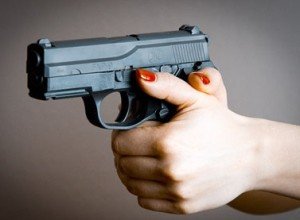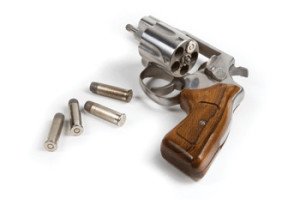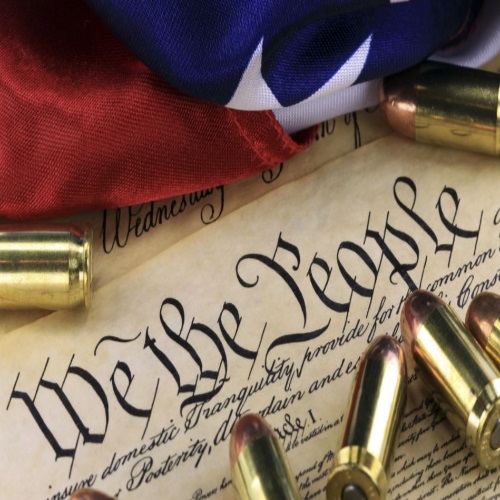- Rule 1: Always treat the gun like it’s loaded
- Rule 2: Always keep the gun pointed in a safe direction
- Rule 3: Always keep your finger off the trigger until you’re ready to shoot
- Rule 4: Always be aware of your target and what is behind it
- Rule 5: Never modify or alter your gun
- Rule 6: Always learn the proper mechanics and operation of your firearm
- Rule 7: Always wear proper protection when shooting
- Rule 8: Always use proper ammunition
- Rule 9: Never rely fully on the firearm’s safety
- Rule 10: Always keep the gun unloaded until you’re ready to use it
- Rule 11: Always properly store your guns
- Rule 12: Never use guns while under the influence of alcohol or drugs
- Rule 13: Always make sure the gun features no obstructions
- Rule 14: Teach children the importance of gun safety
- Rule 15: A gun is not a toy
Here at Gunivore we think there’s a lot to like about guns, and a lot of good reasons to own a gun. From protection, to recreational shooting, to the honoring of the 2nd Amendment, different people own guns for different reasons, none of which are mutually exclusive. Guns can bring family generations closer together and help keep your loved ones safe, but that doesn’t mean that owning a gun is all smooth-sailing. As people can derive via common sense, or as you’ll learn when watching virtually any modern news broadcast, guns do present a danger. Regardless of which side of the gun control issue you find yourself on, that’s a reality that can’t be denied. However, that doesn’t mean that this intangible danger can’t be dealt with accordingly, or the risks associated with firearms heavily diminished through the practicing of proper gun safety.
Practicing Proper Gun Safety Is Integral
Gun safety is the most important subject that there is when it comes to owning and operating a firearm. There are few precautions that can be taken that could be deemed excessive when attempting to mute the dangers of owning a gun, regardless of the circumstances. With that being said, no two situations are exactly alike, and what is a necessary precaution for some may not be so for others. Some people live alone, some have children, and some live with mentally ill family members – there are many factors to consider when weighing your regular gun safety practices. Still, that doesn’t mean that there aren’t a number of baseline, rule of thumb guidelines that all gun owners should adhere to in the interests of safety. Anyone who owns and operates a firearm is going to have circumstances to read and react to that are similar to those of other gun owners, by definition. Ultimately, a gun is always going to be a dangerous object that discharges projectiles at a rapid rate, regardless of other differences that might exist. Keeping that in mind, we would like to present our 15 universal gun safety rules that anyone and everyone can familiarize themselves with for the betterment of their safety:
15 Universal Gun Safety Rules

Rule 1: Always treat the gun like it’s loaded
This is a good general mindset to have whenever operating or holding firearms, no matter the conditions. The logic behind this rule is that someone should never be doing anything with the gun that they wouldn’t otherwise be doing if the gun was loaded. This includes pulling the trigger, tossing the gun, storing it improperly, etc. Additionally, never rely on the word of others when determining whether or not the gun is loaded. If someone hands you a gun and tells you that it’s not loaded, confirm it for yourself before acting accordingly. There’s no reason not to take this precaution when dealing with gun dangers – it’s an easy step towards safety and peace of mind.
Rule 2: Always keep the gun pointed in a safe direction
This is more of a common sense rule than anything else, but it still needs to be listed. Unfortunately, too many folks see movies and television material that glorify the pointing of guns at others, and try to emulate these programs – even in a joking manner, this is dangerous. Unfortunately, this has led to tragic results in the past – you never know when your finger might slip or when a firearm may discharge of its own accord. These are real risks to deal with when holding a firearm, and for the sake of safety, a gun should never be pointed unnecessarily in an unsafe direction.
Rule 3: Always keep your finger off the trigger until you’re ready to shoot
Again this is something that needs to be drilled home to shooters from the first time that they pick up a gun. There are too many different unpredictable events that could lead to an unwanted squeeze of the trigger, and as such you’re better off keeping your finger off of it altogether unless you’re actually preparing to shoot or shooting.
Rule 4: Always be aware of your target and what is behind it
We should really label this one the “Dick Cheney Rule”, although it’s a rule that responsible gun owners have been abiding by since the first gun was manufactured. In 2006, then U.S. Vice President Dick Cheney went on a quail hunt with his friend Harry Whittington. Well, long story short, Cheney fired his 28-gauge shotgun at what he believed to be a bird and ended up hitting Whittington, who suffered from severe injuries as a result of the incident including a collapsed lung and a heart attack. Whittington would luckily come to fully recover, but the negligence shown by Cheney cannot be understated – you must always be fully aware of not only your surroundings, but the surroundings of your target. This includes shooting at a range or at targets in a field – proper gun safety means being aware of what surrounds your target at all times.

Rule 5: Never modify or alter your gun
Gun manipulation and alteration is never a good idea. Attempted modifications to computers have burned down homes in the past – taking risks with a firearm is never a good idea, and that goes for anyone, from novice to expert. Even a gun expert may not be fully familiar with the specifications of the firearm that they’d like to modify, making it a risky proposition to begin altering a model that they themselves did not develop. Any number of problems or errors could come about as a result of attempted gun modification, and as a result it’s a pursuit that gun owners should always steer clear of.
Rule 6: Always learn the proper mechanics and operation of your firearm
Not dissimilar to Rule 5, even for experts, this is an important rule to follow. No two guns are exactly alike and although you may think that you’re capable of diving in to any new firearm – this is not necessarily the case. Advances, alterations and adjustments are made to each and every new firearm, and learning the specifics of them isn’t a particularly long or labor-intensive process. Take the time to learn the ins-and-outs of any firearm that you’re going to be handling and you will be glad you did.
Rule 7: Always wear proper protection when shooting
Unlike most of these rules, wearing protection isn’t necessarily only intended to provide immediate protection – this is important in terms of protecting the gun owner in the long-term as well. Prolonged and consistent exposure to noises that feature unsafe decibel levels can lead to permanent hearing loss in life, even from a young age if the exposure is severe enough. At the age of 65, one in three Americans is already suffering from hearing loss – regardless of whether or not they had been exposed to gun fire in their lives. In other words, you’re already at risk for hearing loss – neglecting your ears can only serve to increase that risk. Make sure that you’re always wearing hearing and eye protection whenever shooting to not only protect from on-the-spot problems, but to for the sake of preserving your hearing in the later in life as well.
Rule 8: Always use proper ammunition
There’s a reason that specific bullets and ammunition are intended to be paired with specific firearms. They were made to be compatible and to function together. As simple as this rule is, it’s quite remarkable how many people choose to ignore it for whatever reason. Imagine for a moment that you load a handgun with a bullet that was not designed to fit through a narrow barrel. If you fire that weapon, the bullet will hit the end of the barrel with force, yet see its passage blocked, the pressure from which will blow up the gun. It probably doesn’t need to be clarified why that would be a dangerous thing.
Rule 9: Never rely fully on the firearm’s safety
Gun’s aren’t perfect, and a gun safety isn’t a mortal lock to not malfunction. With this in mind, it’s always a good idea to treat the gun as if the safety is off, even though it’s on. In other words, the safety being engaged doesn’t mean that you can start pointing the gun wherever you’d like and begin violating all of the rest of the rules on this list. It’s a helpful tool, a gun safety, but it doesn’t render your firearm assuredly safe – always be vigilant when handling your gun.

Rule 10: Always keep the gun unloaded until you’re ready to use it
There isn’t any reason to have ammunition in your weapon if you’re not firing it, and not wanting to have to go through the trouble of loading and unloading the gun is a lazy excuse. You never know what could engage the gun or whose hands it could fall into, and for those reasons alone it is always best to err on the side of caution and only load the gun when you are actually intending to shoot it.
Rule 11: Always properly store your guns
Your gun doesn’t stop being dangerous when it isn’t on your person. If anything, the gun is potentially in an even more precarious state when out of the hands of an experienced, educated gunman and left on its own where it can be found by anyone. It’s for this reason that an imperative aspect of gun safety is making sure that your guns are both locked up and placed in a safe spot. Gun locks, locked drawers, locked gun cabinets – there are a number of versatile options to consider when weighing how to lock up your firearm, but just so long as the gun is in fact safely stored when not in use, you are doing your part to keep yourself and others safe.
Rule 12: Never use guns while under the influence of alcohol or drugs
It’s illegal to operate a vehicle when under the influence of alcohol, regardless of the speed that the car is traveling at. Now, think of how fast a bullet travels, and ask yourself if it’s a good idea to operate a firearm when alcohol is in your system. Firearms should only be handled with a clear and organized mind, and alcohol most certainly can inhibit someone’s ability to think critically and clearly. It should go without saying that guns should never even be a consideration when alcohol is a factor.
Rule 13: Always make sure the gun features no obstructions
Pick up your gun, check the chamber and any other crevices it features, and make sure there is nothing lodged in the weapon that might disrupt your shooting. In the same vein of being aware of your surroundings as well as your target’s surroundings, you should be aware of what is going on in and around your gun. Make sure that your gun is clear and ready for use before firing.
Rule 14: Teach children the importance of gun safety
It’s up to a parents’ discretion whether or not they want to introduce their children to guns from a young age or not. What every parent needs to be aware of, regardless of the exact age that they introduce children to guns, is that the gravity and seriousness of operating a firearm needs to be instilled from day one. Children lack the same seriousness and understanding that adults do, which is why they need the adults in their life to help them understand the importance of gun safety. Teaching these lessons from a young age will help to deeply instill them as well, and ensure a lifetime of proper, safe gun use.

Rule 15: A gun is not a toy
This rule essentially encompasses all of the others within it, as it expresses the underlying sentiment in all of the rules – Take. Guns. Seriously. This can’t be overstated or stressed enough. The bottom line is, a gun is a serious and deadly machine that has the potential to cause serious harm. Anyone who is using a gun needs to recognize this and act accordingly, making sure that every precaution is taken and every safety measure undergone.
If you practice proper gun safety, and you never experience an event that happens as a result of negligence, you’re doing it right. This isn’t a sign that your safety precautions are over the top, it’s an indicator that the safety measures you’re taking are in fact working. Regardless of how safe things may seem, and regardless of your specific circumstances, always abide by the rules and principles expressed in this list. If everyone does, we can be sure that it’ll make for a much safer gun community.



In a few weeks, my sister will finish her gun safety course to buy her first firearm for self-protection. I’m glad you elaborated on the importance of storing your guns properly, and I believe my sister will be too. Thank you for the insight on storing a gun in a safe spot with locked cabinets.